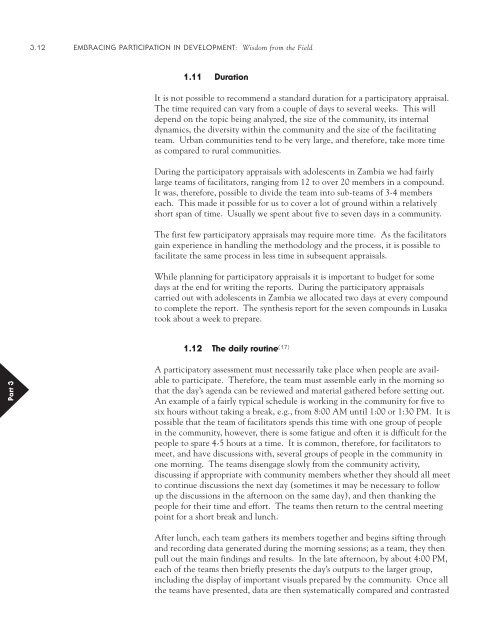PRA-Manual Embracing Participitation tools-only.pdf - PACA
PRA-Manual Embracing Participitation tools-only.pdf - PACA
PRA-Manual Embracing Participitation tools-only.pdf - PACA
Create successful ePaper yourself
Turn your PDF publications into a flip-book with our unique Google optimized e-Paper software.
3.12 EMBRACING PARTICIPATION IN DEVELOPMENT: Wisdom from the Field<br />
1.11 Duration<br />
It is not possible to recommend a standard duration for a participatory appraisal.<br />
The time required can vary from a couple of days to several weeks. This will<br />
depend on the topic being analyzed, the size of the community, its internal<br />
dynamics, the diversity within the community and the size of the facilitating<br />
team. Urban communities tend to be very large, and therefore, take more time<br />
as compared to rural communities.<br />
During the participatory appraisals with adolescents in Zambia we had fairly<br />
large teams of facilitators, ranging from 12 to over 20 members in a compound.<br />
It was, therefore, possible to divide the team into sub-teams of 3-4 members<br />
each. This made it possible for us to cover a lot of ground within a relatively<br />
short span of time. Usually we spent about five to seven days in a community.<br />
The first few participatory appraisals may require more time. As the facilitators<br />
gain experience in handling the methodology and the process, it is possible to<br />
facilitate the same process in less time in subsequent appraisals.<br />
While planning for participatory appraisals it is important to budget for some<br />
days at the end for writing the reports. During the participatory appraisals<br />
carried out with adolescents in Zambia we allocated two days at every compound<br />
to complete the report. The synthesis report for the seven compounds in Lusaka<br />
took about a week to prepare.<br />
1.12 The daily routine (17)<br />
Part 3<br />
A participatory assessment must necessarily take place when people are available<br />
to participate. Therefore, the team must assemble early in the morning so<br />
that the day’s agenda can be reviewed and material gathered before setting out.<br />
An example of a fairly typical schedule is working in the community for five to<br />
six hours without taking a break, e.g., from 8:00 AM until 1:00 or 1:30 PM. It is<br />
possible that the team of facilitators spends this time with one group of people<br />
in the community, however, there is some fatigue and often it is difficult for the<br />
people to spare 4-5 hours at a time. It is common, therefore, for facilitators to<br />
meet, and have discussions with, several groups of people in the community in<br />
one morning. The teams disengage slowly from the community activity,<br />
discussing if appropriate with community members whether they should all meet<br />
to continue discussions the next day (sometimes it may be necessary to follow<br />
up the discussions in the afternoon on the same day), and then thanking the<br />
people for their time and effort. The teams then return to the central meeting<br />
point for a short break and lunch.<br />
After lunch, each team gathers its members together and begins sifting through<br />
and recording data generated during the morning sessions; as a team, they then<br />
pull out the main findings and results. In the late afternoon, by about 4:00 PM,<br />
each of the teams then briefly presents the day’s outputs to the larger group,<br />
including the display of important visuals prepared by the community. Once all<br />
the teams have presented, data are then systematically compared and contrasted














